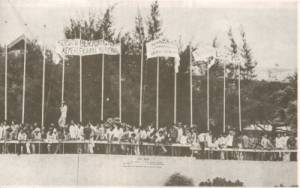THE
STUDENT MOVEMENT IN MALAYSIA,
1967-74 Hassan Karim
Amendments to the University and University Colleges Act, 1975
Student resistance did not end even with the arrest of so many of its leaders. However, pressure from the government in the form of threats and manipulations and the use of racial issues to undermine student unity resulted in the weakening of the student movement.
 The
government capitalized on these weaknesses and vulnerability to table
new draconian laws in Parliament. The 1975 amendements to the UUCA 1971
were passed by Parliament.
The
government capitalized on these weaknesses and vulnerability to table
new draconian laws in Parliament. The 1975 amendements to the UUCA 1971
were passed by Parliament.
Despite protests from students and opposition parties,the amendments were bull-dozed through Parliament. With the enforcement of the Act, all student organisations were dissolved.
This marked the end of an era when the student movement in Malaysia grew to become an important social and politacal force.
As a substitute, the government set up Student Representative Councils, student bodies which have little power, freedom and authority.
Weaknesses in the Student Movement
Every movement has its weaknesses; the following were some of the weaknesses of the MaIaysian student movemerit which was crushed in the mid 1970s:
The Race Problem
The race problem has always been a factor weakening the Malaysian student rnovement. This was paiticularly evident in the case of the universities which have a large multiracial student population, like the University of Malaya. Despite this, there were many issues on which students from the various races united. Such issues incIuded the struggle for university autonomy, opposition to U.S. imperialism, and popular stntg,gles such as Teluk Gong, Tasik Utara and Baling.
Lack of Experience
The tradition of students struggte in Malaya is still young. Hence, students have Iacked experience in facing challenges that have come their way.

